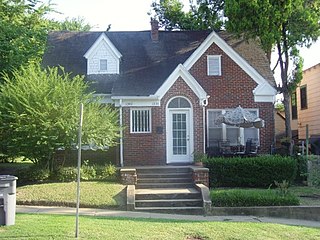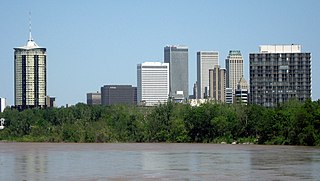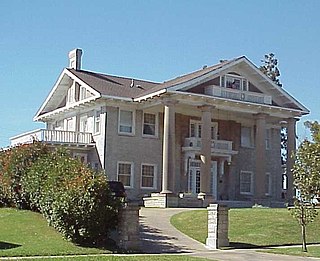
Hyde Park is a neighborhood and historic district in Austin, Texas. Located in Central Austin, Hyde Park is defined by 38th Street to the south, 45th Street to the north, Duval Street to the east, and Guadalupe Street to the west. It is situated just north of the University of Texas and borders the neighborhoods of Hancock and North Loop.

Swan Lake is a historic district in Tulsa, Oklahoma. Its borders consist of 15th Street to the North, Utica Street to the East, 21st Street to the South, and Peoria Avenue to the west. The District was developed in the early 20th century as a middle-class residential area with single-family homes, some duplexes and apartment buildings. It is still considered a highly regarded residential area with a high occupancy rate.

Tulsa is the second-largest city in the state of Oklahoma. It has many diverse neighborhoods due to its size.

The F. Q. Story Neighborhood Historic District is located in central Phoenix, Arizona, United States. The neighborhood runs from McDowell Road south to Roosevelt Street and from Seventh Avenue west to Grand Avenue. The neighborhood as well as many of the individual houses are listed on the National Register of Historic Places.
The Garden District is a residential neighborhood located in Baton Rouge's Mid-City area where Park Boulevard intersects Government Street. The Garden District is an established historic area with many upscale homes and an active civic association.

Brady Heights is a historic district in Tulsa, Oklahoma that was listed on the U.S. National Register of Historic Places in 1980, as Brady Heights Historic District. It was Tulsa's first district to be listed in the Register. According to the NRHP documentation, it is the most complete pre-1920 neighborhood surviving in Tulsa. Its boundaries are Marshall Street to the north, the alley between Cheyenne Avenue and Main Street on the east, Fairview Street on the south, and the Osage Expressway right-of-way on the west. At listing, it included 250 contributing buildings.
Owen Park is a residential neighborhood and historic district in Tulsa, Oklahoma. Its borders are Edison Avenue on the north, the municipal Owen Park on the east, the Keystone Expressway on the south, and Zenith Avenue on the west. Opened on June 8, 1910, it was Tulsa's first municipal park. The district covers 163.48 acres (66.16 ha), while Owen Park itself covers 24 acres (9.7 ha) on the east side of the District.
Gillette Historic District (GHD) is a residential area in the Midtown section of Tulsa, Oklahoma. It consists of the homes on Gillette Avenue and Yorktown Place, and is bounded by 15th Street on the north, the alley between Gillette Street and Lewis Avenue on the east, 17th Street on the south and the alley between Yorktown Place and Yorktown Avenue. It contains 31 single-family homes and 6 duplexes that were constructed between 1924 and 1941. The district were named for James Max Gillette, a merchant, real estate entrepreneur and oilman who built his home in what is now the district in 1921.
Maple Ridge is a historic district in Tulsa, Oklahoma. It is bounded by the Inner Dispersal Loop on the north, Hazel Boulevard on the south, Peoria Avenue on the east and the Midland Valley Railroad right of way on the west. The northern portion of the district, between 15th Street and 21st Street, has been zoned with Historic Preservation Overlay Zoning by the City of Tulsa and is called North Maple Ridge.

Yorktown is a historic district in Tulsa, Oklahoma. It is bordered by 16th and 17th Streets on the north, 20th Street on the south, Lewis Avenue on the east, and Victor/Wheeling Avenues on the west.
Downtown Tulsa is an area of approximately 1.4 square miles (3.6 km2) surrounded by an inner-dispersal loop created by Interstate 244, US 64 and US 75. The area serves as Tulsa's financial and business district; it is the focus of a large initiative to draw tourism, which includes plans to capitalize on the area's historic architecture. Much of Tulsa's convention space is located in downtown, such as the Tulsa Performing Arts Center and the Tulsa Convention Center, as well as the BOK Center. Prominent downtown sub-districts include the Blue Dome District, the Tulsa Arts District, and the Greenwood Historical District, which includes the site of ONEOK Field, a baseball stadium for the Tulsa Drillers opened in 2010.

The Drake Park Neighborhood Historic District is located adjacent to Drake Park near the historic downtown area in Bend, Oregon, United States. Because of the unique and varied architecture in the Drake Park neighborhood and its close association with the early development of the city of Bend, the area was listed on the National Register of Historic Places in 2005.

The Medbury's–Grove Lawn Subdivisions Historic District is a residential historic district located in Highland Park, Michigan. It runs along three east–west streets: Eason Street, Moss Street, and Puritan Street, from Hamilton Avenue on the west to Woodward Avenue on the east. The district was listed on the National Register of Historic Places in 1988.

Rosedale Park is a historic district located in Detroit, Michigan. It is roughly bounded by Lyndon, Outer Drive, Grand River Avenue, Southfield Freeway, Glastonbury Avenue, Lyndon Street and Westwood Drive. It was listed on the National Register of Historic Places in 2006. The Rosedale Park district has the largest number of individual properties of any district nominated to the National Register of Historic Places in Michigan, with 1533.

Central High School is the oldest high school in Tulsa, Oklahoma. It was founded in 1906 as Tulsa High School, and located in downtown Tulsa until 1976. The school now has a 47-acre (19 ha) campus in northwest Tulsa. Tulsa Central is part of the Tulsa Public Schools, Oklahoma's largest school district, and is a public school for students from grades 9 through 12. Since 1997 it has served as a fine and performing arts magnet school.

Woodward Park is a 45-acre (18 ha) public park, botanical garden, and arboretum located between 21st Street and 24th Street east of South Peoria Avenue and west of South Rockford Street in Tulsa, Oklahoma, in the Midwestern United States. The park, named for Helen Woodward, the original property owner, was established in 1929, after a lengthy court suit over ownership.
White City is a residential neighborhood in Midtown, Tulsa, Oklahoma. It is bounded on the north by 2nd Street, on the east by Fulton Avenue, on the south by 11th Street and on the west by Yale Avenue. The neighborhood was added to the National Register of Historic Places in 2001. The area includes 480 buildings, of which 325 retain their historic significance. Two parks are also included in the listing.
Joseph R. Koberling Jr. was a Hungarian-American architect. Born in Budapest, Hungary, he emigrated to the United States, first to San Francisco, then, in 1917, to Tulsa, Oklahoma where he was a student of noted art teacher, Adah Robinson. He was in the first graduation class of Tulsa Central High School. He was then educated at the Armour Institute in Chicago, Illinois. He received a Bachelor of Arts in Architecture in 1925. He returned to Tulsa, where he began practicing. He received his Oklahoma license in architecture in 1929, which he maintained until his death.
Adah Matilda Robinson was an American artist, designer and teacher, who influenced many other artists, especially architects, during the first half of the 20th century. Born in Indiana, she was educated in art schools in the Chicago area, as well as receiving private lessons from noted artist there during the late 19th century. Adah moved with her family to Oklahoma City, where she began teaching art. She moved to Tulsa and became the first art teacher at Tulsa High School. One of the pupils in her first class was the aspiring artist, Bruce Goff. Later, she taught another student, Joseph R. Koberling, Jr., who would also become a noted architect. In 1928, she was hired as the founder and chairperson of the Art Department at the University of Tulsa.

The Fair Oaks Historic District is a nationally recognized historic district located in Muscatine, Iowa, United States. It was listed on the National Register of Historic Places in 2020. At the time it was studied for the Muscatine Historic Preservation Commission it contained 231 resources, which included 176 contributing buildings and 55 non-contributing buildings. Dr. James Weed was an early settler in Muscatine. He married Mary Swift in 1847, and the couple settled a farm on the northeast side of town where they built a Gothic Revival house from 1852 to 1854. The couple donated 63 acres (25 ha) of wooded land on the east side of their property along the Mississippi River for a community park. Along the southern and western edges of their property, they plated subdivisions and eight houses had been built by the time of Mary's death in 1908. The rest of their property was opened up for development at that time and it was given the name Fair Oaks in a city-wide contest. It was divided into 101 lots. There were 57 houses in the subdivision by 1919, and 25 houses and a grocery store were built in the 1920s. Between 1930 and 1944 another 15 houses were built, 11 houses between 1945 and 1954, 13 houses between 1955 and 1965, and four houses since 1965.












